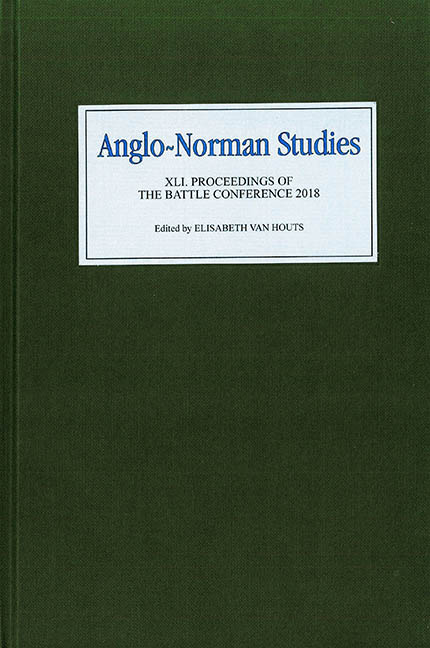Book contents
- Frontmatter
- Contents
- Illustrations and Tables
- Editor's Preface
- Abbreviations
- Horses, Knights and Tactics (The R. Allen Brown Memorial Lecture, 2018)
- Baldwin of Forde, Bartholomew of Exeter and the Authorship of the Liber de sectis hereticorum et orthodoxe fidei dogmata
- Evidence of the Ordinary: Wives and Children of the Clergy in Normandy and England, 1050–1150
- Anthropology, Feud and De obsessione Dunelmi
- New Archaeologies of the Norman Conquest
- An Angevin Imperial Context for the Amboise–Anjou Narrative Programme
- The Noble Leper: Responses to Leprosy in the Twelfth and Thirteenth Centuries
- Royal Taxation and Written Record in Eleventh-Century England and Ninth-Century West Francia
- Early Royal Rights in the Liberty of St Edmund (The Marjorie Chibnall Memorial Essay, 2018)
- Castle Construction, Conquest and Compensation (The Christine Mahany Memorial Lecture)
- Four Scenes from the Chanson de Roland on the Façade of Barletta Cathedral (Southern Italy)
- ‘The Jews are our Donkeys’: Anti-Jewish Polemic in Twelfth-Century French Vernacular Exegesis
- Miscellaneous Endmatter
Four Scenes from the Chanson de Roland on the Façade of Barletta Cathedral (Southern Italy)
Published online by Cambridge University Press: 29 March 2020
- Frontmatter
- Contents
- Illustrations and Tables
- Editor's Preface
- Abbreviations
- Horses, Knights and Tactics (The R. Allen Brown Memorial Lecture, 2018)
- Baldwin of Forde, Bartholomew of Exeter and the Authorship of the Liber de sectis hereticorum et orthodoxe fidei dogmata
- Evidence of the Ordinary: Wives and Children of the Clergy in Normandy and England, 1050–1150
- Anthropology, Feud and De obsessione Dunelmi
- New Archaeologies of the Norman Conquest
- An Angevin Imperial Context for the Amboise–Anjou Narrative Programme
- The Noble Leper: Responses to Leprosy in the Twelfth and Thirteenth Centuries
- Royal Taxation and Written Record in Eleventh-Century England and Ninth-Century West Francia
- Early Royal Rights in the Liberty of St Edmund (The Marjorie Chibnall Memorial Essay, 2018)
- Castle Construction, Conquest and Compensation (The Christine Mahany Memorial Lecture)
- Four Scenes from the Chanson de Roland on the Façade of Barletta Cathedral (Southern Italy)
- ‘The Jews are our Donkeys’: Anti-Jewish Polemic in Twelfth-Century French Vernacular Exegesis
- Miscellaneous Endmatter
Summary
The chansons de geste of French tradition have had a significant impact on the culture and imagination of the populations with whom the Normans came into contact as a result of their conquests in both the north and south of Europe. Among the cycles in which the chansons de geste are traditionally grouped, the epic of Roncevaux is undoubtedly the one that has achieved greatest popularity. This paper is inspired by Rita Lejeune's studies of representations of the Roland legend in the sculptures on the lintel of the cathedral of Angoulême, and on many other church walls throughout Europe. By proposing an interpretation of the enigmatic sculptures on an archivolt of the cathedral of Santa Maria Maggiore in Barletta in light of the propagation of Roland's Song in a large area of Europe, this discussion aims at inserting the city of Barletta into the broad catalogue of churches on whose façades the deeds and ‘martyrdom’ of the paladins of France are celebrated.
The Vikings became notorious in the chronicles because of their raids and sacking of churches and monasteries, so much so that in the liturgy of the ninth to the eleventh centuries the invocation that God might protect the faithful from the fury of the Vikings was introduced. In c. 911, Charles the Simple signed an agreement with the jarl Hrólfr (Rollo) of Norway, allowing Vikings to settle in part of the region to which they gave their name, in exchange for a vassalage relationship and the willingness to receive baptism. In the 150 or so years that followed, Rollo's Vikings not only abandoned the language of their ancestors (that variety of Northern Germanic spoken by the Scandinavian populations) to embrace the idiom of the Franks, but also assimilated the Franks’ social structure and values. The evidence is – if we give credit to the historians of those times – that they soon adopted and tried to actualize the ideals professed by the Church of Rome at the turn of the first millennium: to liberate the territories in the hands of the Arab Muslims, in particular Spain and the Holy Land.
- Type
- Chapter
- Information
- Anglo-Norman Studies XLIProceedings of the Battle Conference 2018, pp. 193 - 208Publisher: Boydell & BrewerPrint publication year: 2019



